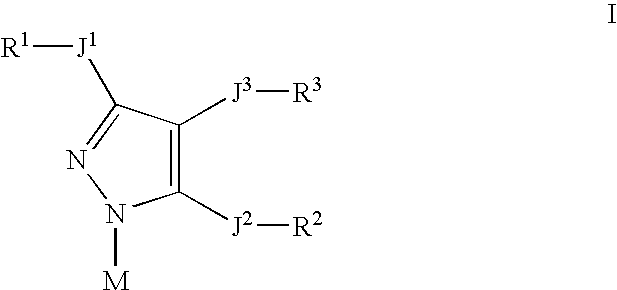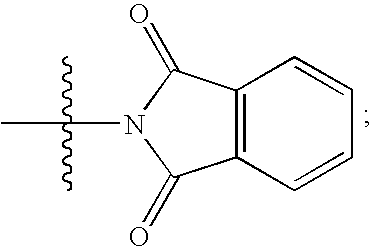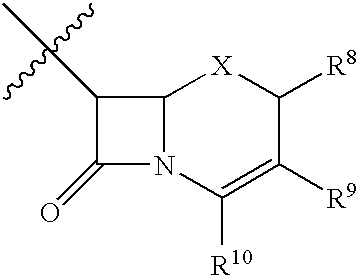Pyrazolyl inhibitors of 15- lipoxygenase
a technology of pyrazolyl inhibitors and 15-lipoxygenase, which is applied in the field of pyrazolyl inhibitors of the enzyme 15-lipoxygenase, can solve problems such as serious disorders
- Summary
- Abstract
- Description
- Claims
- Application Information
AI Technical Summary
Benefits of technology
Problems solved by technology
Method used
Image
Examples
example 1
A. 4-Azido-1-thiophen-2-yl-butan-1-one
A mixture of 4-chloro-2′-butyrothienone (3.0 g, 15.9 mmol) and sodium azide (2.07 g, 31.8 mmol) in DMF (50 mL) was stirred at 70° C. for 1.5 h. The reaction mixture was then partitioned between ethyl acetate (200 mL) and water (200 mL). The organic layer was washed with water (100 mL), saturated aqueous sodium bicarbonate (100 mL) and brine (100 mL) and dried over sodium sulfate. Removal of the solvent in vacuo provided the title compound (2.58 g, 83% yield). MS m / e 218; HPLC retention time 0.85 min (Method B).
B. 2-(2-Azido-ethyl)-1-pyrazin-2-yl-3-thiophen-2-yl-propane-1,3-dione
A suspension of pyrazine 2-carboxylic acid (2.52 g, 20.3 mmol) in dichloromethane (30 mL) at 0° C. was treated with oxalyl chloride (1.95 mL, 22.3 mmol) followed by the addition of catalytic DMF (1 drop). The reaction mixture was allowed to warm to room temperature overnight, then concentrated in vacuo to give pyrazine 2-carbonyl chloride as a violet-colored solid. ...
examples 2 to 26
Examples 2 to 26 were prepared following the procedures described for the preparation of 1.
ExampleRtAnalyticalM / z#Structure(min)HPLC Method(MH)+23.47A48731.89B48641.71B45853.40A48363.02A45572.01A52882.73A55792.50A527102.52A552112.65A566122.24A600132.48A552142.42A552153.88A566162.31A490172.77A593182.95A538192.46A524202.57A571212.46A553222.53A567232.46A553243.73A542251.51B560262.47A556
example 27
4-Pentyl-N-[2-(5-pyrazin-2-yl-3-thiophen-2-yl-1H-pyrazol-4-yl)-ethyl]-benzenesulfonamide
A mixture of the 2-(5-Pyrazin-2-yl-3-thiophen-2-yl-1H-pyrazol-4-yl)-ethylamine 1D (7 mg, 25.8 μmol), diisopropylethylamine (9.0 μl, 51.6 μmol) and 4-n-pentylbenzenesulfonyl chloride (7.0 mg, 28.3 μmol) in dichloromethane (1 mL) was stirred for 3 h. The reaction mixture was concentrated under reduced pressure. The crude product dissolved in methanol (2 ml) and was purified by prep-HPLC. Removal of the solvent in vacuo provided the title compound (3.8 g mg, 41% yield). MS m / e 481; HPLC retention time 3.54 min (Method A).
PUM
| Property | Measurement | Unit |
|---|---|---|
| Electric potential / voltage | aaaaa | aaaaa |
Abstract
Description
Claims
Application Information
 Login to View More
Login to View More - R&D
- Intellectual Property
- Life Sciences
- Materials
- Tech Scout
- Unparalleled Data Quality
- Higher Quality Content
- 60% Fewer Hallucinations
Browse by: Latest US Patents, China's latest patents, Technical Efficacy Thesaurus, Application Domain, Technology Topic, Popular Technical Reports.
© 2025 PatSnap. All rights reserved.Legal|Privacy policy|Modern Slavery Act Transparency Statement|Sitemap|About US| Contact US: help@patsnap.com



